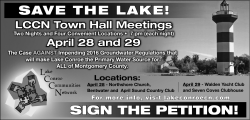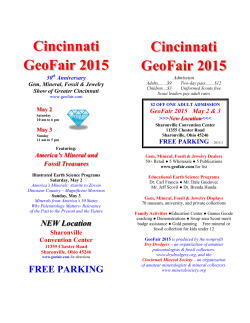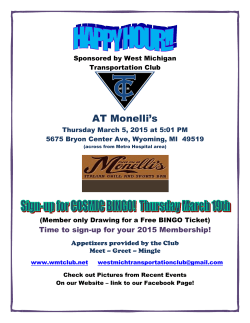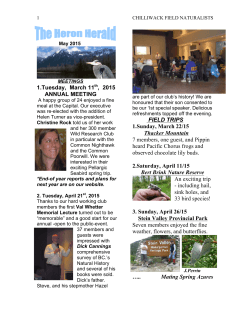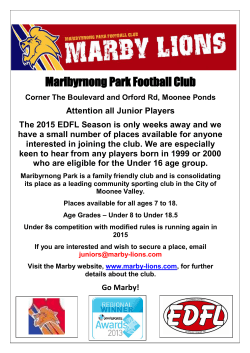
April, 2015 - LGGMclub.org
The Lake George Gem and Mineral Club Club Monthly Meeting, April 11, 2015 Regular Meeting of the Lake George Gem & Mineral Club Saturday, April 11, 9:00AM ( Note return to Summer hours) Lake George Community Center After the business meeting, Club President John Rakowski will present a program on Pikes Peak area collecting John Rakowski, a local geologist and mineral collector, will give a presentation about our local geology as it pertains to collectible mineral specimens, and will discuss some tips for successful, fun mineral collecting on public or private lands in our area. There will be examples of mineral specimens from the Florissant-Lake George area. We’ll start with a PowerPoint general presentation, then all congregate around a table where some of the specimens can be viewed and discussed in detail. We’ll talk about distinguishing clear/white varieties of quartz – topaz – fluorite – calcite. We’ll discuss variable colors within the same mineral, fluorite specifically. There will be examples of the rock types pointing you toward a pegmatite. John began collecting minerals in this area as a hobby in the early 1960’s and later went on to earn a degree in geology. He has worked as a professional exploration geologist for over 40 years and still enjoys rocks and minerals as a hobby. • We will continue with the winter silent auction. We still have great specimens from various donors, including some fluorescents, a few radioactive minerals, and some material from the Crystal Peak area. Dues are due….see membership application at the end of this Newsletter. After April 1, unpaid members will be removed from the Newsletter & e-mail lists and will Not be able to attend Club trips. Coming Events Fort Collins Rockhounds 54th Annual Gem & Mineral Show, March 27-29, McKee 4-H Building, Larimer Co. Fairgrounds. Go to www.fortcollinsrockhounds.org for information. Lake George Gem and Mineral Club April, 2015 “The Resurrection of the Rittenhouse: Saving Mining History”, 1PM April 15; meet at the mine site, 300 block of south 4th St., Victor; cost is $10 (cash only) per person, payable at the mine site. Info and registration at victorcolorado.com. Colorado Mineral & Fossil Show (Spring), April 24-26, Ramada Plaza Motel, 4849 Bannock St., Denver. Free admission and parking; mzexpos.com for information. Spring CSM Museum Sale of books, minerals, fossils, maps, etc. April 25-26, 9AM to 4PM, 1310 Maple St., Golden. Friends of Mineralogy (Colorado Chapter) Silent Auction, May 9, 12-3PM, Clements Community Center, 1580 Yarrow St., Lakewood; contact Mark Jacobson (markivanjacobson@gmail.com ) for information. The New Fairplay Contin-Tail Gem & Mineral Show, June 11-14, free admission and parking. 3rd Annual Victor Gem & Mineral Show, June 20-21, downtown Victor. Free admission and parking. Info at stcfg@victorcolorado.com. Gunnison Mining & Minerals Symposium, July 10-13, Western State University, Gunnison, Friends of the Colorado School of Mines Geology Museum; registration and fees required. Contact m_l_smith@earthlink.net for info. Original Contin-Tail Gem, Mineral, and Fossil Show, August 13-16, free admission and parking, Buena Vista Rodeo Grounds (Colorado’s largest outdoor gem and mineral show). Info at coloradorocks.org. Lake George Gem & Mineral Club Annual Gem & Mineral Show, Aug. 20-23, in the field next to the Lake George P.O. Free admission and Free parking. The following clubs meet regularly and welcome visitors. Go to their websites for more information. Cañon City Geology Club, second Monday of each month; 6:00, First Methodist Church Fellowship Hall, 9th St. and Main, C.C. Colorado Springs Mineralogical Society, third Thursday of each month; 6:30, Colorado Springs Senior Center, 1514 N. Hancock, C.S. Columbine Gem & Mineral Society, second Thursday of each month; 6:30, Shavano Manor, 525 W. 16th (at J St.), Salida. Pueblo Rockhounds, third Thursday of each month, 6:30 (new time), Westminster Presbyterian Church, 10 University Circle, Pueblo. Club News Please Welcome the Following New Members Effi & Jon DeVaney (Vail) Sherrine Kochen (Pueblo West) Arlene Langdon (Olney Springs) Conrad North (Centennial) John Russell John & Charlotte Wild (Minneapolis, MN) Karen Vogl (Florissant) Lake George Gem and Mineral Club April, 2015 At the December meeting, the following officers and committee chairs were elected for 2014: Officers: President: John Rakowski Vice President: Char DeVries Treasurer: Suzanne Core Secretary: Norma Engelberg Newsletter Editor: Bob Carnein Directors: Annual Show Chair: Rebecca Blair Field-Trip Coordinator: Todd Mattson Pebble Pups Coordinator: Steve Veatch Webmaster: Dan Alfrey Notice to Members We sold out of Club hats with the new logo on them very quickly. A number of members have asked if we are going to reorder. We are willing but have no current plans to do so. (We do still have a number of tee-shirts available, most at $7.00 preshrunk.) If you are interested in a hat, please email your interest to suzcster@gmail.com , and if there is enough interest, Suzanne will collect payments of $10 per hat. Then, we will put in another hat order. Here’s a note from Suzanne Core about membership renewal: April 1st is not only April Fool's Day. It is also "your last day as a Club member" if you have not sent in your application and dues for 2015. You will be removed from the email (i.e., newsletter and field-trip) list at that time as well. You can print the application off the website, but we are asking all renewing members to fill out one of the new application forms this year so we have a more complete and up-to-date record. We also hope you will “tick off” some of the boxes at the bottom of that form! Thank You! Steve Veatch sent this report about Pebble Pups: Three CSMS Pebble Pups were coauthors on a paper that was presented last weekend at the WIPS Fossil Symposium at the Colorado School of Mines. This paper was published in the Proceedings of the Symposium. One of the co-authors is a CSMS "distance" Pebble Pup who lives in Scotland. Two of these Pebble Pups presented this paper with me at the symposium. In addition, the Pebble Pups worked together and had a case at the symposium. This was a watershed moment in the lives of these three teenage Pebble Pups. Rebecca Blair wanted to remind everyone to Save-The-Date for our LGGMC Annual Gem & Mineral Show !!! Aug. 20-21-22-23, in the field next to the Lake George Post Office Free admission and Free parking. Please see Rebecca or Char to see how you can help! Frank Rosenberg sent these photos of a recent collecting trip to Arroyo Gulch, a garnet locality near Cañon City: Lake George Gem and Mineral Club April, 2015 Weather was clear and slushy… Sharon Holte, hard at work in the schist… Ellie Rosenberg and Bob Carnein playing in the snow Bring your hand lens! Todd Mattson, our field-trip coördinator, has two trips planned so far this spring: May 16: New Hope Amethyst Claim (hosted by the Cañon City Geology Club; Jennifer Gerring and Jim Meacham). Contact Todd at 719-963-4449 or tmattsondbc@live.com for information. May 30: Patience and Piety Claims (Wigwam Creek), led by John Rakowski (contact John at 719-748-3861 or rakgeologist@yahoo.com for information). July 18: Petra Placer, led by Rich Fretterd (strenuous) August 1: Ace in the Hole, Rich Fretterd Other Possible Trips: Holcim Quarry, Smoky Hawk; Topaz Mtn. Gem Mine; St. Peters Dome; Goethite Hill; Arroyo Gulch (see above); Blue B Barite (Dave Harvey). Member Mike Sandifer recently took part in a different kind of rockhound field trip: the National Rock Stacking Contest at Llano, Texas: Note Mike’s hat, and some typical entries… Lake George Gem and Mineral Club April, 2015 Here are this month’s “Bench Tips” from Brad Smith: DIVIDERS A set of dividers is a tool I find very useful in laying out the geometry of a piece I'm making. It has two needle-like tips with an adjustment to set the spacing between them. They can be used to transfer a measurement. Let's say you need a 7-mm-wide strip of sheet metal. Set the spacing between the divider tips to 7 mm on the ruler. Then lay the sheet on the bench, put one tip against the edge, and run the dividers down the edge, scribing a line parallel to the edge. Dividers can be used to mark equal segments of a line or arc. For instance, assume a line between A and B that might be straight or curved, and you want to divide it into 5 equal lengths. Set the dividers to an estimate of the distance. Starting at Point A, use the dividers to mark off five lengths along the line. If you end up short of Point B, lengthen the distance on the dividers. If you end up overshooting Point B, shorten the length of your dividers. After a few tries, the length on the dividers will be the exact distance you need to mark the 5 segments. Dividers can let you quickly find the center of a circular disk. With one tip of the dividers at the edge of the disk, set the other tip to an estimate of where the center might be. Fix one tip of the dividers at the 3 o'clock position and scribe an arc with the other tip near the center. Do this again from the 6 o'clock, 9 o'clock, and 12 o'clock positions. The arcs at the center will form a small four-sided box. The center of the box is at the center of the disk. - - - - - - - - - - - - - - - - - - - PIECE OF LEATHER Leather has a multitude of uses in the shop. I often use a scrap of it to avoid scratching the back of a piece of jewelry while setting stones. It's also great for times when you need to clamp one of your tools in a vise, for instance a drawplate. ========================================= Get all 101 of Brad's bench tips in "Bench Tips for Jewelry Making" on Amazon Earth-Science Scholars/Pebble Pups Corner Here's the schedule for this year's remaining Pebble Pups/Earth-Science Scholars classes and activities: April: National Poetry Month Earth-Science Scholars and Pebble Pups meet from September through May on the third Tuesday of each month at 6PM in the Pikes Peak Historical Museum (in Florissant). Be sure you check regularly at www.LGGMClub.org for details and updates, or contact Steve Veatch at steven.veatch@gmail.com. Remember, new students and their parents are always welcome; Earth-Science Scholars and Pebble Pups are welcome on LGGM Club field trips. Lake George Gem and Mineral Club April, 2015 Notes from the Editor Bob Carnein, Editor ccarnein@gmail.com 719-687-2739 This month, I’m pleased to include a short article by Steve Veatch about the Garden of the Gods, along with an article by yours truly that continues the series on the Mohs hardness scale. PIKES PEAK REGION’S ICONIC ROCKS by Steven Wade Veatch Steamboat Rock and Balanced Rock are well-known tourist attractions in the heart of the Garden of the Gods. These iconic rocks were once privately owned, but today they are part of Colorado Springs’ famous city park. Steamboat Rock once had steps carved into the rock that went to its top. Tourists eagerly climbed up to the observatory to view the beautiful geological wonders. Balanced Rock, the 700-ton attraction, has—for millions years—withstood the inexorable forces of nature, including wind, cycles of freezing and thawing, earthquakes, and relentless erosion. Both scenic rocks are eroded sections of the Fountain Formation, a sandstone composed of unsorted sand and pebbles of many sizes that were washed down from the Ancestral Rocky Mountains. . Lake George Gem and Mineral Club April, 2015 Figure 1. Early photograph of tourists visiting Balanced Rock (R) and Steamboat Rock (L). In this undated photo a man is enjoying the natural beauty of the area with three female companions in a horsedrawn buggy. Curt Goerke, a 14-year-old entrepreneur, began taking photos of tourists in front of the rocks in the 1890s, selling them each for 25 cents. Photo from the collection of S.W. Veatch. Figure 2. This view of Steamboat Rock, on a postcard, was taken about 40 years later than the image in figure 1. Few changes are noted in the physical condition of Steamboat rock. A sign read, “Steamboat Rock Observatory. Use of the telescopes free to visitors. All welcome.” Photo from the collection of S.W. Veatch. The Fountain Formation began to form long before the dinosaurs roamed Colorado. A rapid mountain uplift, known as the Colorado Orogeny, began 300 million years ago that produced an ancestral range of Rocky Mountains. Rain and intense thunderstorms produced torrents of water with enough energy to move rock, ranging in size from tiny grains to large clasts. These eroded sediments—from the Ancestral Rockies nearby to the west—piled up at the base of these ancient mountains as gravels and formed the Fountain Formation. This rock unit, up to 4,500 feet thick, has a deep red color from the chemical alteration of iron minerals. The rock fragments in the Fountain Formation are angular indicating the fragments were not deposited far from their source. A number of the Garden of the God’s landmarks, including Steamboat Rock and Balanced Rock, were shaped by erosion. Erosion continues today. About the author: Steven Veatch is a writer and geoscientist. His family came to the Cripple Creek and Victor Gold Mining District in the early 1890s where they mined for almost more than three decades. The other side of his family mined in the Caribou District in Boulder County, Colorado. Veatch lives next to the Florissant Fossil Beds National Monument. Lake George Gem and Mineral Club April, 2015 “Tenacious Topaz” by Bob Carnein As the “old timers” in the Club may remember, I started a series of articles on the minerals of Mohs’ hardness scale some time ago. You can find them in the past issues of the newsletter for the following dates: talc: March, 2011; gypsum: November, 2011; calcite: February, 2012; fluorite: November, 2010; apatite: October, 2012; K-feldspar: March, 2013; quartz: September, 2013; and corundum: November, 2013. Only two minerals remain: topaz and diamond. This article takes care of number 8. Introduction. Topaz is number 8 on the Mohs’ hardness scale. It’s an aluminum silicate with significant fluorine and hydroxyl. Its chemical formula is Al2SiO4(F,OH)2. Other, commoner crustal aluminum silicates, include potassium feldspar (orthoclase, microcline) and plagioclase. Crystallography. Topaz is in the rhombic-dipyramidal class of the orthorhombic crystal system, and nice crystals, some weighing up to nearly 600 pounds, are relatively common (Klein and Hurlbut, 1999). Crystals tend to be rich in forms (Fig. 1), most being dominated by prisms with vertically striated faces (Fig. 2). The vertical striations help the collector to distinguish topaz from quartz, which has horizontal striations on its prism faces. Physical Properties. Because of its high hardness and relatively high specific gravity (averaging around 3.5), topaz is often concentrated in placer gravels. Crystals may have slightly rounded edges or may be completely rounded by transport and commonly have a frosted appearance from bouncing against other rocks (Fig. 3). Crystals at the Topaz Mountain Gem Mine, in Park County, Colorado, range from nearly pristine to Figure 1. “Typical” topaz crystal, showing cleavage. (galleryhip.com) Lake George Gem and Mineral Club Figure 2. “Imperial” topaz, showing vertical striations. (pinterest.com) April, 2015 completely rounded. The relatively high specific gravity helps the collector or gemologist to distinguish topaz from a wide variety of stones that may be confused with it, including tourmaline, andalusite, apatite, danburite, phenakite, scapolite, brazilianite, and gem orthoclase. Figure 3. Water-worn topaz crystal. (australianmuseum.net.au) Figure 4. Topaz showing cleavage and internal reflections. (www.GemWow.com) Besides crystal habit and specific gravity, topaz can often be identified by its highly perfect basal cleavage. The cleavage produces flat, glassy breakage surfaces perpendicular to the c axis (Fig. 4). Cracks in the cleavage direction sometimes produce internal reflections, or “rainbows”, in transparent stones. Occurrence. Fine crystals of topaz generally occur in granitic pegmatites. Famous localities include the Pikes Peak batholith in central Colorado (Fig. 5, 6); Ouro Preto (imperial topaz; Fig. 2) and Minas Gerais, Brazil; Nerchinsk, Siberia; Mursinsk, Ural Mts., Russia; Schneckenstein, Germany; Mardan, Pakistan (Fig. 7); and many others. Fine topaz crystals also occur in cavities in rhyolitic “lavas” (many of which are actually welded tuffs), such as those of the Figure 5. Topaz from Topaz Mtn. Gem Mine, Park Co., CO (Carnein photo and collection) Lake George Gem and Mineral Club Figure 6. Topaz from Agnus Dei claim, El Paso Co., CO. (Carnein photo) April, 2015 Thomas Range, Utah (Fig. 8), and, sparingly, at Ruby Mountain, near Nathrop, Colorado. Acicular crystals resembling natrolite occur with sanidine at Wannenköpfe, Eifel, Germany (Fig. 9). The beautiful reddish brown (but non-transparent) crystals from Tepetate, San Luis Potosi, Mexico occur in rhyolite and owe their color to rutile inclusions (Fig. 10). Figure 7. Purple topaz from Pakistan. (en.Wikipedia.org) Figure 8. Topaz from Topaz Mountain, UT. (nhmu.utah.edu) Figure 9. Topaz from Germany. (www.dakotamatrix.com) Figure 10. Topaz from Tepetate, Mexico. (www.rosellminerals.com) Although topaz crystals are common, the mineral also occurs in irregular masses, especially in the rock known as greisen. Greisen results from high temperature hydrothermal alteration of granitic rocks. It usually occurs near the borders of granitic intrusions. Besides topaz, greisen commonly contains quartz, muscovite, and schorl, and it may contain commercially valuable minerals such as beryl (as in the Badger Flats area, east of Wilkerson Pass), cassiterite (the main ore of tin), and wolframite (tungsten ore), as well as other metals. Massive topaz may be difficult for the beginner to Lake George Gem and Mineral Club April, 2015 recognize, but the cleavage, high hardness, and high specific gravity are all useful. In the Badger Flats area, the topaz is yellowish in color . Topaz doesn’t offer much for the fluorescent mineral collector. Hydroxyl rich yellow, brown, pink, and red stones commonly fluoresce weakly or moderately in LWUV and more weakly in SWUV (Hurlbut and Kammerling, 1991). The fluorescent color is usually orange-yellow or dull orange. In my collection, some “imperial” topaz from Brazil exhibits this reaction. Blue or colorless fluorine rich stones normally don’t fluoresce or fluoresce a weak yellow or greenish color. My specimens from Joe Dorris’s Topaz Mountain Gem Mine and Rich Fretterd’s Agnus Dei claim are inert to UV. Gemology. Topaz has a vitreous (glassy) luster and moderate refractive index. Combined with its high hardness, common occurrence as transparent crystals, and attractive colors, these properties make it a popular gemstone. It is the “official” birthstone for November. Topaz isn’t commercially synthesized, but, like many gemstones, it is often faked. Gemstone dealers have been known to substitute glass or citrine (yellow quartz, itself usually heat treated) or smoky quartz (so-called “smoky topaz”), reserving the term “precious topaz” for the real thing. Pale blue, yellow, yellow brown, and orangey brown are common colors. Figure 11. Some colors of gem topaz. (www.gettyimages.com) Be aware that some natural colors are fugitive—exposure to heat or light may cause the color to change. Most pale to medium red stones are heat treated. However, Pakistan Lake George Gem and Mineral Club April, 2015 currently produces rare, natural pale pinkish purple gems. The popular saturated blue (“London blue”, “super blue”, “blue max”, etc.) colored gems are stones that have been treated with gamma rays and other, more energetic, forms of radiation in linear accelerators and nuclear reactors. This often must be followed by heating to get rid of unwanted secondary brown colors (Hurlbut and Kammerling, 1991). Such treatment is controversial for several reasons: (1) it may be undetectable; (2) it often produces colors that are unstable to low light; and (3) it may pose a health risk to the wearer. For example, London blue topaz is produced in nuclear reactors and must be stored for a period of time until the induced radiation decreases to “acceptable” levels (Hurlbut and Kammerling, 1991). The treatment may be quite elaborate, involving exposure to gamma radiation, then treatment in nuclear reactors, followed by linear accelerators, and, finally, heating to produce the desired result. Let the buyer (and the wearer) beware! References Hurlbut, C.S., Jr., and R.C. Kammerling, 1991, Gemology, Second Edition: New York, John Wiley & Sons. Klein, C., and C.S. Hurlbut, Jr., 1999, Manual of Mineralogy (after James D. Dana), Twenty-First Edition, Revised: New York, John Wiley & Sons, Inc. Please take time to re-New your Membership ☺ Consider volunteering to Lead a Field Trip! The success of our Annual Gem & Mineral Show is because of our amazing Membership participation by great peeps, like You! ( please see Rebecca or Char to learn how you can help ) Lake George Gem and Mineral Club April, 2015 MEMBERSHIP APPLICATION Lake George Gem & Mineral Club Box 171, Lake George, Colorado 80827 www.LGGMclub.org Date: Name _______/_______/20______ ____________________________________________________________________________ Address ________________________________City __________________State ______ Zip _________ Telephone ( ) ______ - ____________ E-mail ________________________________________ (email Required to receive Newsletter and Field Trip info.) Names/Ages of family members (if family membership): _______________________________________ ____________________________________________________________________________________ Dues for Jan. 1 through Dec. 31 each year are as follows: _____ Individual (18 and over) …………………………………………………….. $15.00 _____ Family (includes dependents under age 18) ….…………………..………. $25.00 st st st Due are Due after January 1 . * Members w/ unpaid dues by March 31 will be deleted on April 1 . On/after August 31, dues will be pro-rated by one-half for NEW members only. √ I agree to Abide by Club Constitution, By-Laws, and Rules regarding Field Trips & Club Claim visits: √ Signed _______________________________________________ Date: _______/_______/________ I am or have previously been a member of Lake George Gem & Mineral Club. Yes ____ No _____ My interest areas include (check all that apply): Minerals ______ Fossils______ Lapidary ______ Micromounts _____ Colorado Geology _____ Pebble Pups (ages 7-17) ______ Mining History _____ Crystallography _____ Other (be specific): ___________________________________________ I am willing to give a talk/presentation to [the Club] or [Pebble Pups] on __________________ (topic) and/or Lead Field Trip(s) to ___________________________________________________________ I am willing to participate/help in the following ways (can choose more than one): Club Officer ______ News Writer-Contributor ______ Annual Show Committee _______ Nominating Committee _________ Winter Programs _____ Field Trips ______ Membership Coordinator ______ Scholarship/Education Committee _________ Pebble Pups ________ Other (be specific): __________________________ Questions about the Club or Activities? Please visit the website or contact a Club Officer. Lake George Gem and Mineral Club Updated 2/4/2015 April, 2015 Lake George Gem and Mineral Club P.O. Box 171 Lake George, CO 80827 www.LGGMclub.org The Lake George Gem and Mineral Club is a group of people interested in rocks and minerals, fossils, geography and history of the Pikes Peak/South Park area, Indian artifacts and the great outdoors. The club’s informational programs and field trips provide an opportunity to learn about earth sciences, rocks and minerals, lapidary work and jewelry making, and to share information and experiences with other members. Guests are welcome to attend, to see what we are about! The club is geared primarily to amateur collectors and artisans, with programs of interest both to beginners and serious amateurs. The club meets the second Saturday of each month at the Lake George Community Center, located on the north side of US Highway 24 on the east edge of town, sharing a building with the county highway shops. In the winter we meet at 10:00 AM. ( From April through October, we meet at 9:00 AM, to allow more time for our field trips. ) Our organization is incorporated under Colorado law as a nonprofit educational organization, and is a member of the Colorado, Rocky Mountain and American Federations of Mineralogical Societies. We also sponsor an annual Gem and Mineral show at Lake George, where collectors and others may purchase or sell rocks, minerals, fossils, gems or jewelry. Annual membership dues (Jan. 1 through Dec. 31) are $15.00 for an individual (18 and over), and $25.00 for a family (Parents plus dependents under age 18). Our Officers for 2015 are: John Rakowski, President PO Box 608 Florissant, CO 80816 719-748-3861 rakgeologist@yahoo.com Suzanne Core, Treasurer PO Box 1154 Cripple Creek, CO 80813 719-689-2092 suzc@peakinet.net C.R. (Bob) Carnein, Editor, 507 Donzi Trail, Florissant, CO 80816 719-687-2739 ccarnein@gmail.com Lake George Gem and Mineral Club Char DeVries, Vice President 280 Homestead Rd. Divide, CO 80814 719-686-1822 swordfishblue@wildblue.net Norma Engelberg, Secretary 2732 W. Bijou St. Colorado Springs, CO 80904 719-337-8994 njengel60@gmail.com April, 2015
© Copyright 2024
